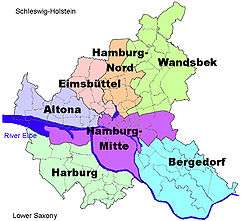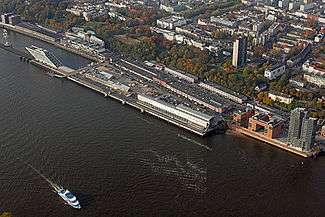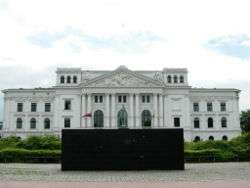Altona, Hamburg
| Altona | ||
|---|---|---|
| Borough of Hamburg | ||
|
Sol LeWitt, Black Form Dedicated to the Missing Jews, townhall Altona (Altona-Altstadt). | ||
| ||
 Altona | ||
Boroughs of Hamburg  | ||
| Coordinates: 53°33′0″N 9°56′0″E / 53.55000°N 9.93333°ECoordinates: 53°33′0″N 9°56′0″E / 53.55000°N 9.93333°E | ||
| Country | Germany | |
| State | Hamburg | |
| City | Hamburg | |
| Borough | Altona | |
| Founded | 1535 | |
| Area | ||
| • Total | 77.5 km2 (29.9 sq mi) | |
| Population (31.12.2006) | ||
| • Total | 243,972 | |
| • Density | 3,100/km2 (8,200/sq mi) | |
| Time zone | CET/CEST (UTC+1/+2) | |
| Dialling codes | 040 | |
| Vehicle registration | HH | |

Altona (German pronunciation: [ˈaltona]) is the westernmost urban borough (Bezirk) of the German city state of Hamburg, on the right bank of the Elbe river. From 1640 to 1864 Altona was under the administration of the Danish monarchy. Altona was an independent city until 1937. In 2006 the population was 243,972.
History
Founded in 1535 as a village of fishermen in then Holstein-Pinneberg. In 1640, Altona came under Danish rule as part of Holstein-Glückstadt, and in 1664 received city rights from Danish King Frederik III, then ruling in personal union as duke of Holstein. Altona was one of the Danish monarchy's most important harbour towns. The railroad from Altona to Kiel, the Hamburg-Altona–Kiel railway (Danish: Christian VIII Østersø Jernbane), was opened in 1844.
Because of the severe restrictions on the number of Jews allowed to live in Hamburg (with the exception of the period of 1811–15,) until 1864,[1] a major Jewish community developed in Altona starting in 1611, when Count Ernest of Schaumburg and Holstein-Pinneberg granted the first permanent residence permits to Ashkenazic Jews.[2] Members did business both in Hamburg and in Altona itself. All that remains after the Nazi Holocaust during World War II are the Jewish cemeteries, but in the 17th, 18th and 19th centuries, the community was a major center of Jewish life and scholarship. The Holstein-Pinneberg and later Danish Holstein had lower taxes and placed fewer civil impositions on their Jewish community than did the government of Hamburg.
The wars between Denmark and the German Confederation, such as the First Schleswig War (1848–1851) and the Second War of Schleswig (February 1864 – October 1864) followed by the Gastein Convention (1864), led to Denmark's cession of the Duchies of Schleswig, Holstein and Lauenburg to Prussian and Austrian administration, respectively. Along with all of Schleswig-Holstein, Altona became part of the Kingdom of Prussia in 1867.
In 1871 Altona and the nearby city Hamburg were hit by cholera, with a minimum of 16 casualties in Altona.[3]
During the Weimar era following World War I, the city of Altona was disturbed by major labor strikes and street disorders. Inflation in Germany was a major problem. In 1923 Max Brauer, the mayor of Altona, directed that city personnel be paid in part with gas meter tokens, as these coins did not lose value from inflation.[4] The most notable event at this time is the Altona Bloody Sunday (German: Altonaer Blutsonntag) on July 17, 1932 when several persons were shot by the police force during a demonstration of Nazi groups. After police raids and a special court, on August 1, 1933 Bruno Tesch and others were found guilty and put to death by beheading with a hand-held axe.[5][6] In the 1990s, the Federal Republic of Germany reversed the convictions of Tesch and the other men who were put to death, clearing their names.
The Greater Hamburg Act removed Altona from the Free State of Prussia in 1937 and merged it (and several surrounding cities) with the Free and Hanseatic City of Hamburg in 1938.
On 1 February 2007 the Ortsämter (Precincts) in Hamburg were dissolved. In Altona the precincts of Blankenese, Lurup and Osdorf had existed and had local offices. On 1 March 2008 the Schanzenviertel neighborhood, which had spanned across parts of the boroughs of Altona, Eimsbüttel and Hamburg-Mitte, became the Sternschanze quarter, the entirety of which is now in the Altona borough.[7]
Geography

The border of Altona to the south is the River Elbe, and across the river the state Lower Saxony and the boroughs Harburg and Hamburg-Mitte. To the east is the borough Hamburg-Mitte and to the north is the borough Eimsbüttel. The western border is with the state of Schleswig-Holstein. According to the statistical office of Hamburg, the area of Altona is 77.5 km² or 29.9 sq mi in 2006.
Quarters
Politically, the following quarters (German Stadtteile) are part of Altona borough:
- Altona-Altstadt
- Altona-Nord
- Bahrenfeld
- Ottensen
- Othmarschen (including parts of Klein Flottbek)
- Groß Flottbek
- Osdorf
- Lurup
- Nienstedten (including parts of Klein Flottbek)
- Blankenese
- Iserbrook
- Sülldorf
- Rissen
- Sternschanze
Demographics
In 2006 Altona had a population of 243,972 people. 16.4% were children under the age of 18, and 18.6% were 65 years of age or older. 15.3% were immigrants. 12,545 people were registered as unemployed.[8] In 1999 48% of all households were made up of individuals.[9]
There were 37 elementary schools and 30 secondary schools in Altona and 635 physicians in private practice and 67 pharmacies.[10]
Diet of the borough
Simultaneously with elections to the state parliament (Bürgerschaft), the Bezirksversammlung is elected as representatives of the citizens. It consists of 51 representatives.
Elections
Elections were held in Hamburg on 20 February 2011. The five parties having more than 5 percent in recent polls (minimum to qualify) are the conservative CDU, the social-democratic SPD, the ecologist Green Party (GAL), the left-wing Die Linke and the liberal Free Democratic Party (FDP).
Transport
Altona is the location of a major railway station, Hamburg-Altona, connecting the local rapid transit with the regional railways and local bus lines.
The Bundesautobahn 7 leads through Altona borough.
According to the Department of Motor Vehicles (Kraftfahrt-Bundesamt), in Altona 87,131 private cars were registered (359 cars/1000 people).[10]
Notable residents
- Jean de Labadie (1610–1674), French Christian mystic who died in Altona.
- Jonathan Eybeschutz (1690–1764), was a Talmudist, Halachist, and Kabbalist who died in Altona.
- Johann Friedrich Struensee (1737–1772), doctor of medicine, de facto ruler of Denmark
- Conrad Hinrich Donner (1774–1854), banker and philanthropist, of Donners Park, Altona
- Akiba Israel Wertheimer (1778–1835), was chief Rabbi in Altona from 1815–35
- George Jarvis (Philhellene) (1797–1828), was the first of the American Philhellenes who took part in the Greek Revolution 1821-1829, general of Greek army, born in Altona.
- Johannes Groenland (1824–1891), botanist and microscopist who worked for Louis de Vilmorin in Paris and was born in Altona.
- Sophie Wörishöffer (1838–1890), was a writer of adventure stories for young people who died in Altona.
- Constantin Brunner (1862–1937), German philosopher, grandson of Akiba Israel Wertheimer, was born in Altona
- Karl Yens (1868–1945), plein-air painter of Southern California, born in Altona.
- Ernst Thälmann (1886–1944), leader of the Communist Party of Germany (KPD) during much of the Weimar Republic, born in Altona.
- Johannes de Boer (1897–1986), Highly decorated Generalleutnant during World War II, was born in Altona.
- Carl Theodor Sørensen, (1893–1979), Danish landscape architect was born in Altona
- Eric Maxim Choupo-Moting, (born 1989), Cameroonian footballer was born in Altona
See also
- Hamburg Altona electoral district, covering the borough
- Altoona, Pennsylvania - named after Altona, Hamburg
Notes
- ↑ Jewish Encyclopedia: Hamburg - 'In 1619... it was agreed that, in consideration of a payment made for their protection, the Jews should be tolerated in the town as strangers, though they were not to be allowed to practise their religion publicly...', 'In 1648 the council of aldermen issued an order expelling the German Jews("Hochdeutsche Juden") from the town. They moved to Altona, and were required to pay a monthly tax...', and 'In 1697 the freedom of religious practise which the congregation had obtained was disturbed by hostile edicts of the aldermen, and the Jews were extortionately taxed. On this account many of the rich and important Portuguese Jews left Hamburg, some of them laying the foundation of the Portuguese congregation of Altona.' (The Jewish Encyclopedia)
- ↑ Lowenthal, Marvin (1977), The Memoirs of Glückel of Hameln, New York: Shocken Books, pp. 5–10, ISBN 978-0-8052-0572-5
- ↑ "Colera", The New York Times, 1871-08-31
- ↑ Verg, Erich; Verg, Martin (2007), Das Abenteuer das Hamburg heißt (in German) (4th ed.), Hamburg: Ellert&Richter, p. 158, ISBN 978-3-8319-0137-1
- ↑ "Back to the Axe!", The Time Magazine, 1933-08-14, retrieved 2008-08-14
- ↑ Stolpersteine in Hamburg |url=http://87.106.6.17/stolpersteine-hamburg.de/en.php?&LANGUAGE=EN&MAIN_ID=7&BIO_ID=234|
- ↑ Act of the area organisation
- ↑ Residents registration office, source: statistical office Nord of Hamburg and Schleswig-Holstein (2006)
- ↑ Source: statistical office Nord of Hamburg and Schleswig-Holstein (1999)
- 1 2 Source: statistical office Nord of Hamburg and Schleswig-Holstein (2006)
References
- Statistical office Hamburg and Schleswig-Holstein Statistisches Amt für Hamburg und Schleswig-Holstein, official website (German)
- Act of the areal organisation, July 6, 2006 Gesetz über die räumliche Gliederung der Freien und Hansestadt Hamburg (RäumGiG) (German)
- Stolpersteine Hamburg Stolpersteine in Hamburg (German)
External links
| Wikimedia Commons has media related to Altona. |
-
 Altona-St. Pauli travel guide from Wikivoyage
Altona-St. Pauli travel guide from Wikivoyage - altona.INFO newspaper with daily local information
-
 "Altona". Encyclopædia Britannica (11th ed.). 1911.
"Altona". Encyclopædia Britannica (11th ed.). 1911.


